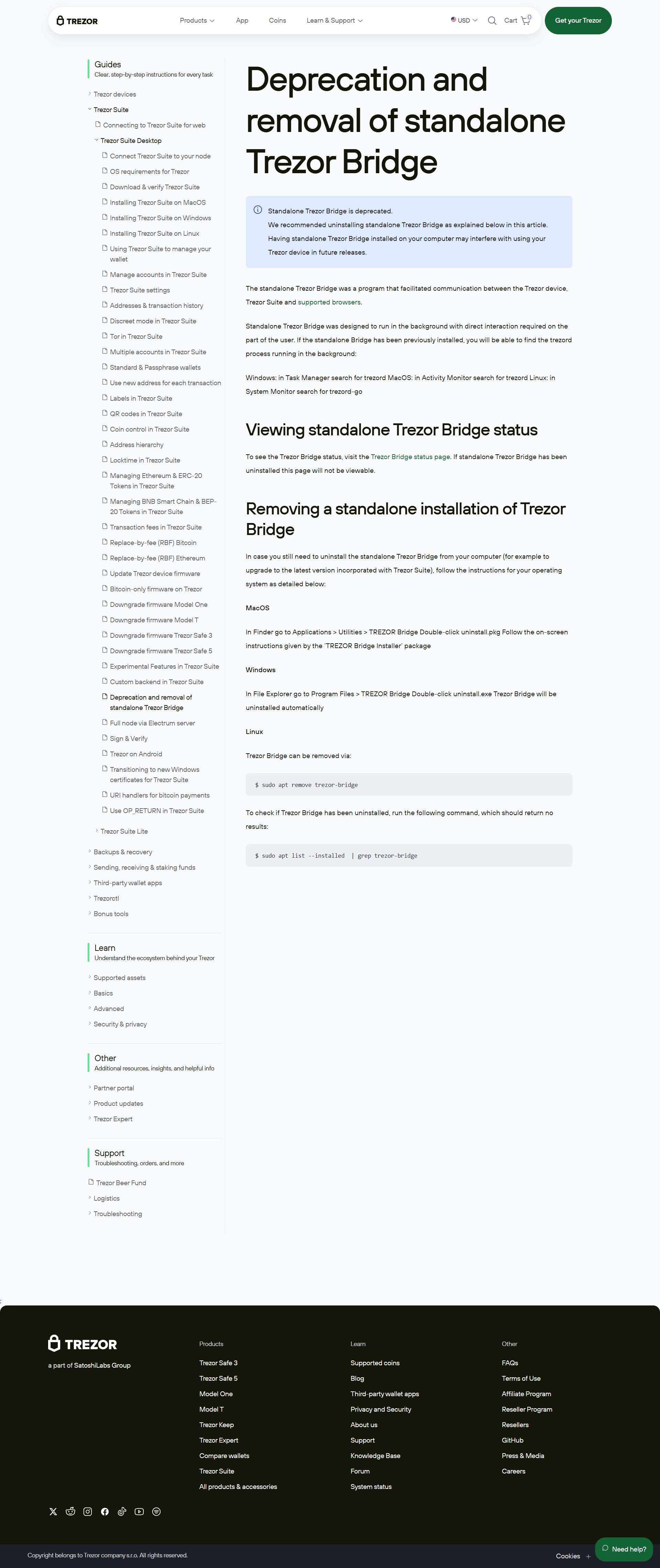Trezor Bridge: The Ultimate Guide to Secure and Seamless Hardware Wallet Communication
Introduction to Trezor Bridge
Trezor Bridge is a specialized communication software that connects your Trezor hardware wallet to your desktop browser or operating system. Unlike browser extensions or web-only solutions, Trezor Bridge ensures robust, consistent, and secure communication between your Trezor device and compatible wallet interfaces such as Trezor Suite.
It serves as an essential backbone for Trezor users who want full control of their cryptocurrencies in a safe, private, and flexible environment. This guide explains everything about Trezor Bridge—what it is, why you need it, how it works, how to install it, and how it compares with alternatives.
What is Trezor Bridge?
At its core, Trezor Bridge is a lightweight background service (or daemon) that runs on your computer. It acts as an intermediary between your browser or desktop app and the Trezor device itself. Without it, your computer cannot "talk" directly to the hardware wallet in a secure and standardized way.
Bridge replaces the older Trezor Chrome Extension, which was phased out due to browser restrictions and security concerns. Unlike the old extension, Trezor Bridge works across all modern browsers, including Chrome, Firefox, Brave, and Edge, on Windows, macOS, and Linux.
Why Do You Need Trezor Bridge?
If you’re serious about hardware wallet security, you need reliable communication between your wallet app (like Trezor Suite) and your device. Browsers limit direct USB access for security reasons. That’s where Trezor Bridge comes in:
- Universal compatibility: Works with all major browsers without extra plugins.
- Enhanced security: Prevents phishing or malicious scripts from hijacking device communication.
- Seamless user experience: Automates the process of detecting and talking to your Trezor device.
- Future-proofing: Designed to work with evolving operating systems and browsers.
In short, Bridge is essential for anyone using a Trezor hardware wallet outside of mobile apps.
Key Features of Trezor Bridge
Here are some of the standout features that make Trezor Bridge the best solution for secure device communication:
1. Cross-Platform Support
Trezor Bridge runs on Windows, macOS, and Linux. It offers the same functionality and user experience on all supported systems.
2. Browser Agnostic
Unlike old browser extensions limited to Chrome, Bridge supports Chrome, Firefox, Edge, Brave, and more—no extra plugin required.
3. Secure Communications
Bridge uses secure local connections between your computer and Trezor hardware, mitigating risks of man-in-the-middle attacks.
4. Easy Installation
The installation process is simple, with clear guides and automatic device detection.
5. Automatic Updates
Bridge can be updated to ensure it remains compatible with new browser or OS versions.
How Trezor Bridge Works
Technically, Trezor Bridge is a small server running on your local machine. When you open your browser and navigate to Trezor Suite (Web) or a supported wallet, the app sends commands to Bridge running locally. Bridge, in turn, communicates with your connected Trezor device over USB.
This three-part model is:
- Browser/App → 2. Bridge → 3. Hardware Wallet
This design ensures your device is never directly exposed to risky web pages or scripts. All communication goes through a vetted, secured local process.
Step-by-Step: How to Install Trezor Bridge
Installing Trezor Bridge is straightforward. Here’s a detailed guide:
1️⃣ Download the Installer
Visit the official Trezor website at trezor.io/bridge and choose the installer for your operating system:
- Windows (.exe)
- macOS (.pkg)
- Linux (.deb/.rpm)
2️⃣ Run the Installer
Follow the prompts. On Windows, you may need admin privileges.
3️⃣ Restart Your Browser
After installation, close and reopen your browser to ensure it can detect Bridge.
4️⃣ Connect Your Trezor Device
Plug in your Trezor Model T or Trezor One. The browser app or Trezor Suite will detect it automatically via Bridge.
5️⃣ Verify Connection
Open Trezor Suite (Web or Desktop). It will confirm that the device is connected via Bridge.
System Requirements
For best results, make sure your system meets these requirements:
- Windows: 10 or higher recommended
- macOS: 10.13 (High Sierra) or newer
- Linux: Debian-based (.deb) or Red Hat-based (.rpm) distributions
- Browser: Chrome, Firefox, Edge, Brave (latest versions recommended)
Use Cases: When Do You Need Trezor Bridge?
You need Trezor Bridge in these common scenarios:
- Accessing Trezor Suite Web in a browser (as opposed to the standalone desktop app)
- Connecting to third-party wallets or dApps via browser integration
- Running Trezor in enterprise environments with strict browser security policies
- Developing custom wallet integrations with Trezor devices
Bridge is particularly critical for users who prefer browser-based workflows but want uncompromising hardware wallet security.
Keeping Trezor Bridge Up to Date
Updates to Trezor Bridge improve security and compatibility. Always install the latest version:
- Trezor's website automatically offers the latest installer.
- Some OS packages support system updates via package managers.
- New versions often fix bugs, support new browsers, and improve performance.
Troubleshooting Trezor Bridge
Here are common issues and solutions:
🔹 Browser Doesn’t Detect Trezor
- Make sure Bridge is installed and running.
- Restart your browser after installation.
- Try a different browser (some older versions may block local connections).
🔹 Bridge Won’t Install
- Check your OS version compatibility.
- On Linux, install with
sudoif required.
🔹 Connection Errors
- Try reconnecting the device.
- Use a different USB cable/port.
- Ensure no conflicting apps (e.g., Ledger Live) are accessing USB devices simultaneously.
Security Considerations
- Official Source Only: Always download Bridge from trezor.io. Avoid third-party or unofficial packages.
- Local Server: Bridge runs only on your machine. It doesn’t send data externally except to the Trezor interface.
- Open Source: Trezor’s tools, including Bridge, are open source, making it auditable for security.
Made in Typedream
